To Plug Or Not To Plug—Prius & Prius Prime Answer the Question
Since the beginning of the 21st century, Toyota’s Prius has been the hybrid leader. Its Hybrid Synergy Drive System seamlessly matches a gasoline engine with an electric motor, saving fuel with no action needed by the driver.
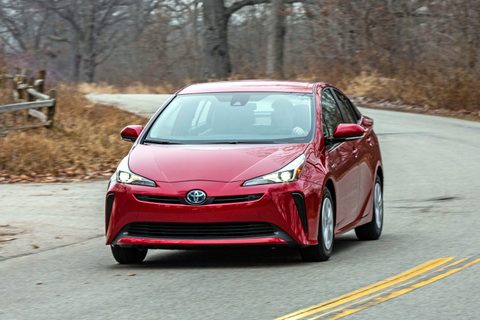
With the plug-in Prius, Toyota introduced a car that could serve as an all-electric car for local driving, but reverts to a hybrid for longer drives, eliminating range anxiety. The latest version is called the Prius Prime.
I just drove a standard 2019 Toyota Prius and a 2020 Toyota Prius Prime back-to-back for a week each, to learn their similarities and differences. The choice may come down to what will work best with your lifestyle. and driving needs.
Similarities & Differences
Both Priuses wore blue: The standard car was Electric Storm Blue while the Prime flaunted Blue Magnetism. Blue is often identified with “green” cars, so this seems appropriate.
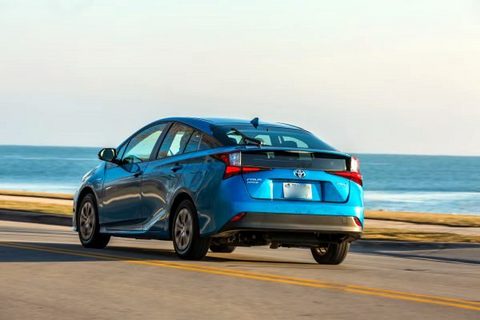
Both cars look essentially the same on the outside at 10 paces, except for the front and rear ends. My 2019 regular Prius showed off a new look with trimmed back headlights and tail lamps and reduced edginess. It looks a bit more mainstream, which is not a bad thing.
The Prime features a more flowing shape, with a more sensuously rounded rear window, although both Priuses have split rear windows that can impede vision when you’re backing up.
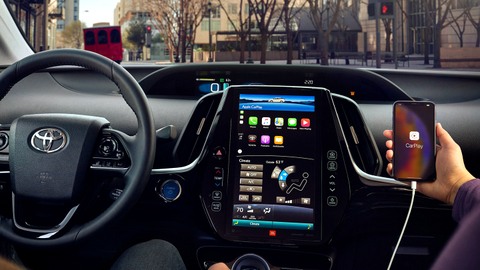
Inside, the cars look and feel similar, but the Prime, with presumably more interesting information to convey with its battery system, flaunts a larger dash center touchscreen—11.6 inches vs. the 8.1-inch one on the standard car. It’s mounted vertically, kind of like Volvo and Tesla’s. The Prime plays a piano tune and shows a video of the car driving up or down a white sphere when you turn it on and off, which helps you know if the car is on or off—an issue with EVs. You can silence it if you so desire.
New Technology
My standard tester offered all-wheel drive (AWD), which is new, and would likely be a benefit in places with worse weather than I experienced in June in Northern California. The AWD models use a nickel-metal hydride (NiMH) battery, while non-AWDs employ lithium-ion. Toyota says this is because NiMH batteries work better in cold conditions where an AWD Prius might find itself.
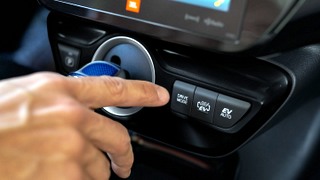
The Hybrid Synergy Drive system works the same in both cars. The car’s electronic brain blends power from the 96-horsepower 1.8-liter gas engine and the 71-horsepower, 53-kilowatt (kW) electric motor for the most efficient performance (the total system horsepower is a modest 121).
You can select from three drive modes—Normal, Eco and Power—in both cars. These control how power is delivered for varying levels of efficiency. Eco provides more gradual acceleration and Power lets you enjoy more aggressive driving. Normal works fine for everything, but I tended to shift to Eco on longer drives.
The Biggest Differences—Plug & Price
The biggest difference, though, is the presence of an 8.8-kilowatt-hour chargeable battery and plug in the Prime, which allows up to 25 miles of pure electric driving. In the plain Prius, you can press the EV Auto button on a level surface with a full battery and get maybe a mile of 25 mph EV cruising, but with the Prime, I set the button to make it all-electric for all my driving. When the chargeable battery was depleted, the car smoothly reverted to hybrid mode. Otherwise, it sailed as smoothly as any pure EV out there in all conditions.
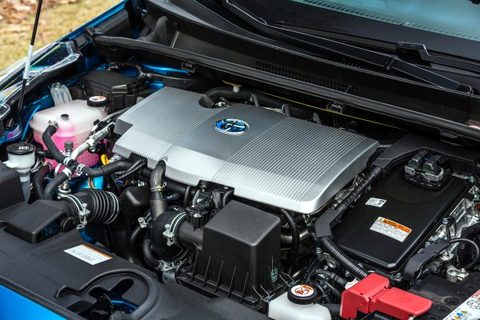
My Prime tester outweighed the standard car by 155 pounds, thanks to the larger battery. The Prime’s battery also took up room in the cargo bay, raising the rear floor a few inches, reducing cargo volume by nearly five cubic feet.
Pricing on the two cars is significantly different. My standard Prius was an XLE model with all-wheel drive, and base priced at $28,820. With several options, including 15-inch alloy wheels ($899), an Advanced Technology Package ($800) that included a color head-up display, and illuminated door sills ($299), the bottom line, with shipping, came to $32,195.
The Prius Prime Advanced started at $33,350 and with the same optional alloys and door sills and a couple other things, topped out at $36,085. That’s about the starting price of a pure electric vehicle, such as the Chevrolet Bolt EV or Nissan Leaf.

Efficiency numbers are 52 mpg city/48 highway/50 combined for the regular Prius. The Prime gets two numbers—54 mpg if you use gasoline only (i.e. never plug it in) and 133 MPGe when using electricity and gas (compare to other plug-in vehicles). Although the EPA Green numbers are identical (7 for Smog and 10 for Greenhouse Gas), the Prime will save you $4,000 in fuel costs over five years compared to the average car versus $3,250 for the standard model.
With its decades of experience, Toyota really knows how to build a great hybrid. But how do you choose between a regular hybrid and a plug-in? Think about how you drive. If, like me, you commute back and forth to the train station two miles from home and run errands around town, with diligent charging you can essentially drive an electric car, with all the quiet, smooth, clean motoring you want. If you travel longer distances regularly, the benefits of the 25 miles of local battery range are not really as useful, and a standard hybrid would be a better and less expensive choice.
Make sure to opt-in to the Clean Fleet Report newsletter (top right of page) to be notified of all new stories and vehicle reviews.
More Stories You Might Enjoy—Hybrids & Plug-in Hybrids
Road Test: 2019 Chevrolet Bolt EV
Road Test: 2019 Nissan Leaf 62 kWh
Road Test: 2019 Nissan Leaf 40 kWh
Road Test: 2018 Hyundai Ioniq PHEV
Road Test: 2017 Hyundai Ioniq Hybrid
First Drive: 2020 Toyota Corolla Hybrid
Road Test: 2019 Honda Insight Hybrid
Road Test: 2019 Ford Fusion PHEV
Comparison Test: 2017 Ford Fusion Hybrid & PHEV
Disclosure:
Clean Fleet Report is loaned free test vehicles from automakers to evaluate, typically for a week at a time. Our road tests are based on this one-week drive of a new vehicle. Because of this we don’t address issues such as long-term reliability or total cost of ownership. In addition, we are often invited to manufacturer events highlighting new vehicles or technology. As part of these events we may be offered free transportation, lodging or meals. We do our best to present our unvarnished evaluations of vehicles and news irrespective of these inducements.
Our focus is on vehicles that offer the best fuel economy in their class, which leads us to emphasize electric cars, plug-in hybrids, hybrids and diesels. We also feature those efficient gas-powered vehicles that are among the top mpg vehicles in their class. In addition, we aim to offer reviews and news on advanced technology and the alternative fuel vehicle market. We welcome any feedback from vehicle owners and are dedicated to providing a forum for alternative viewpoints. Please let us know your views at publisher@cleanfleetreport.com.

Woow! Thanks for sharing nice information
@Deepti,
Always glad to help. Have you got any other comparisons you think we should test? –ed.